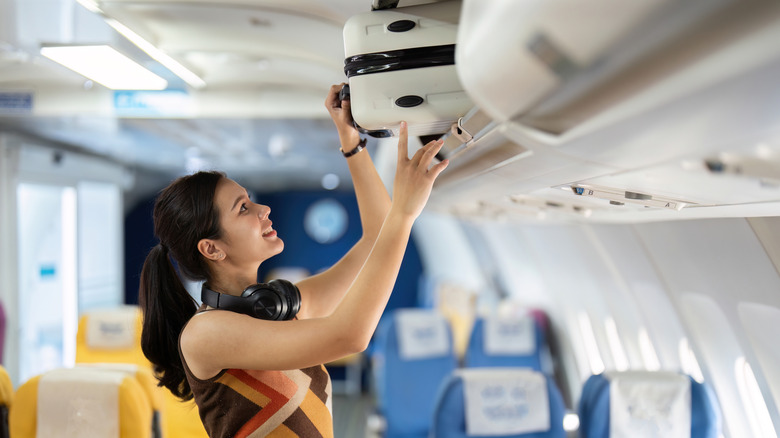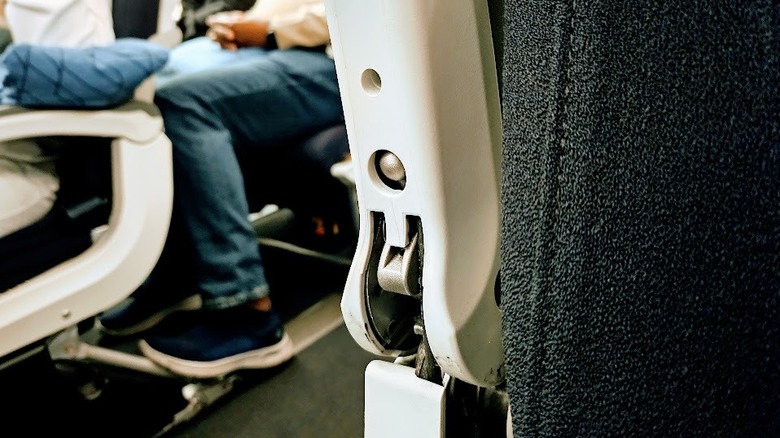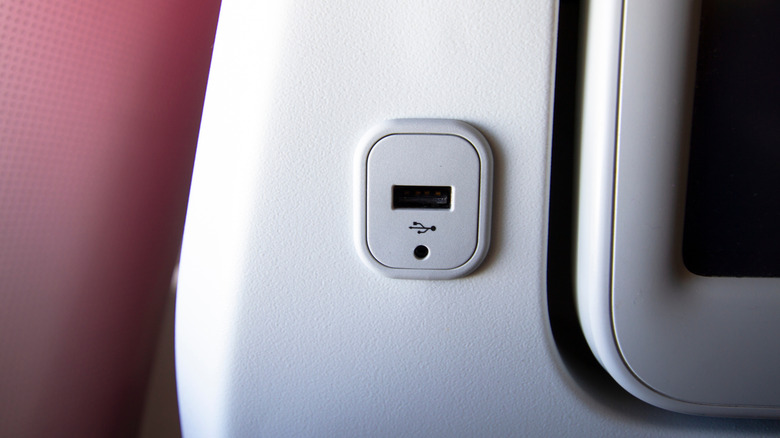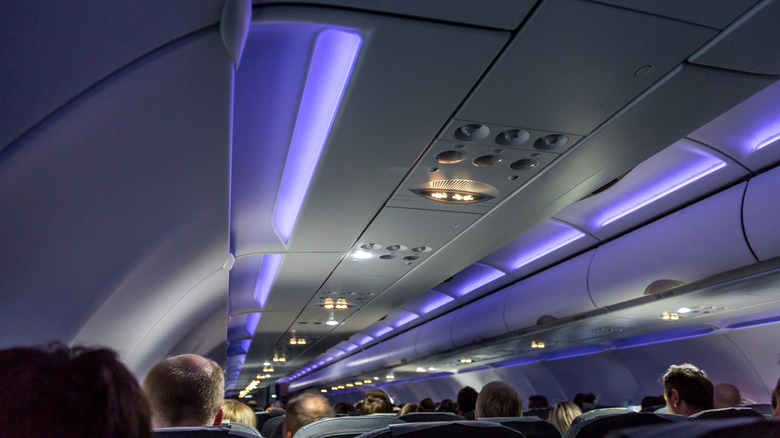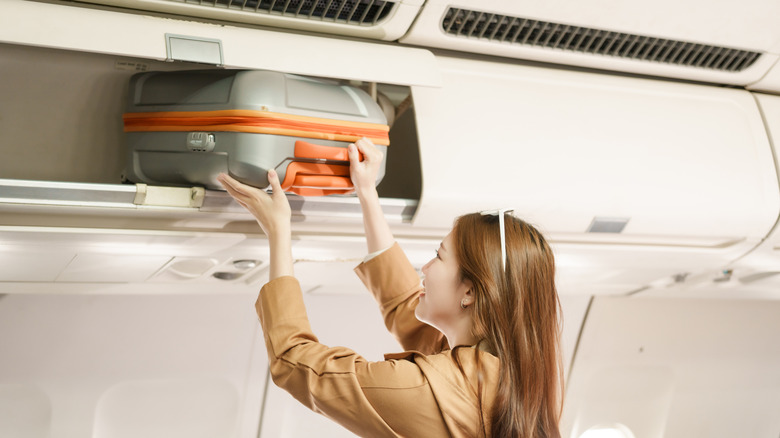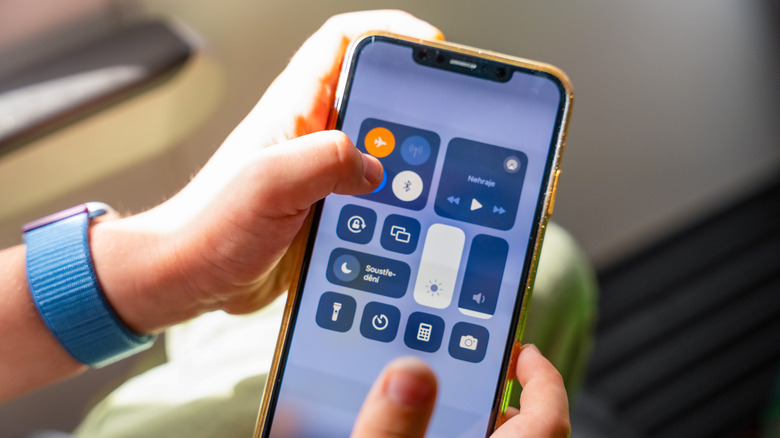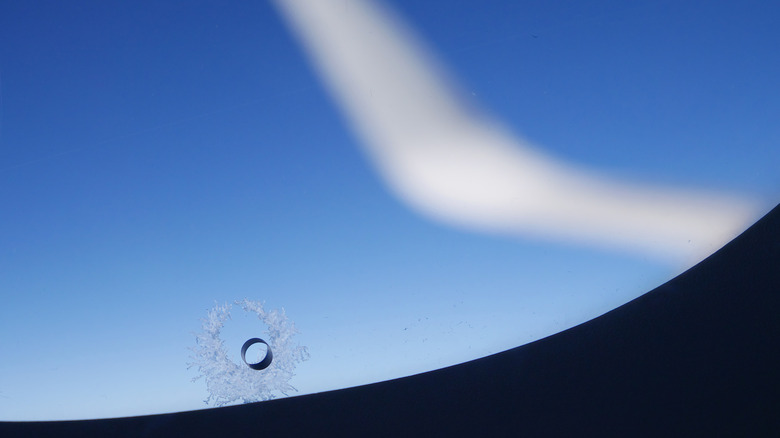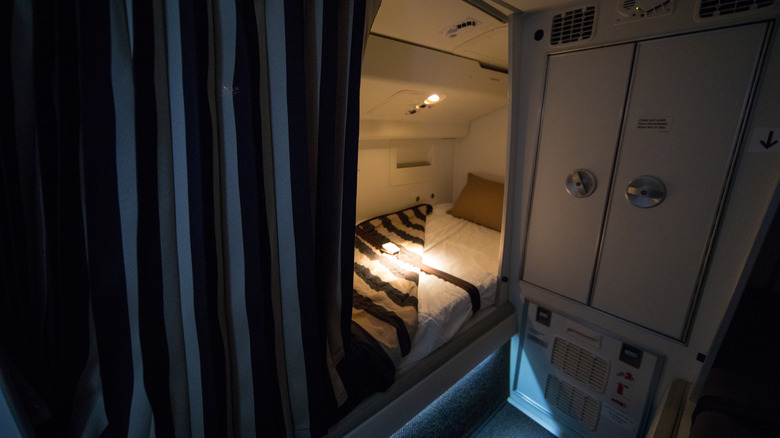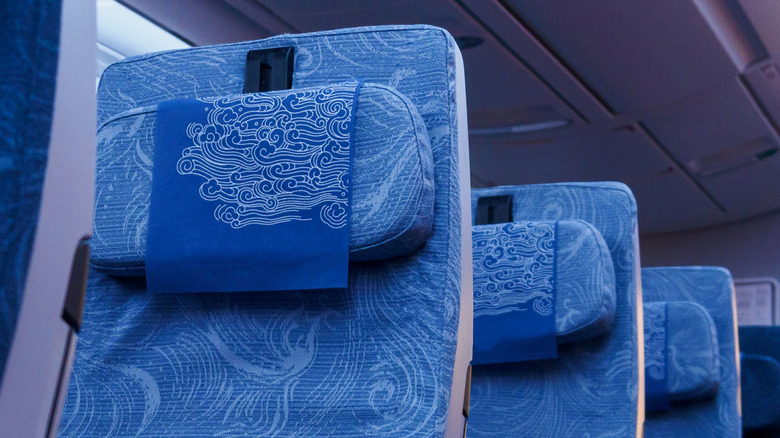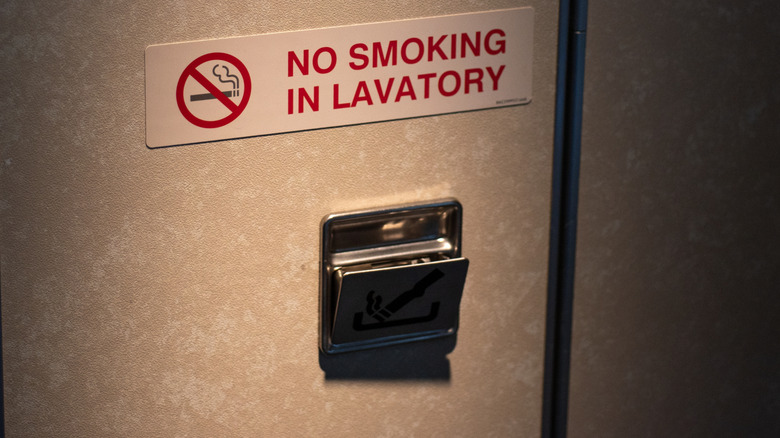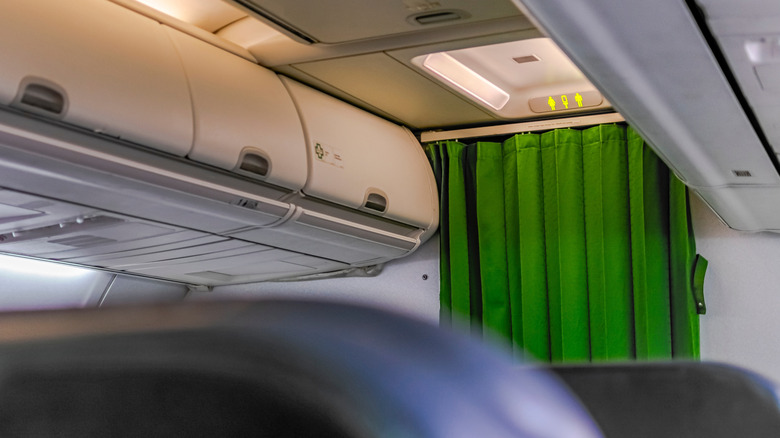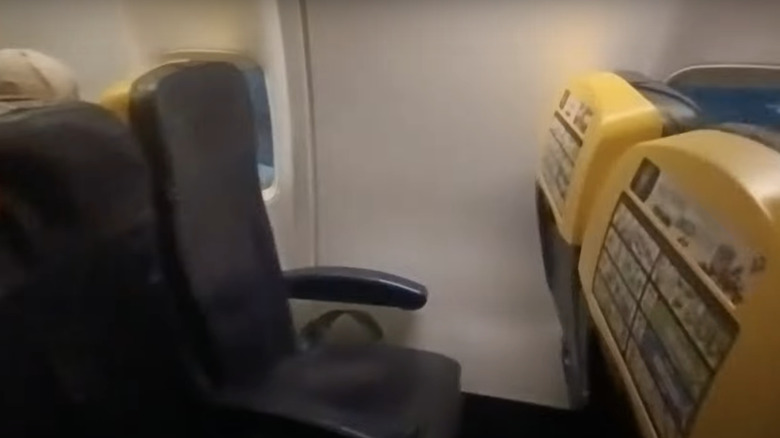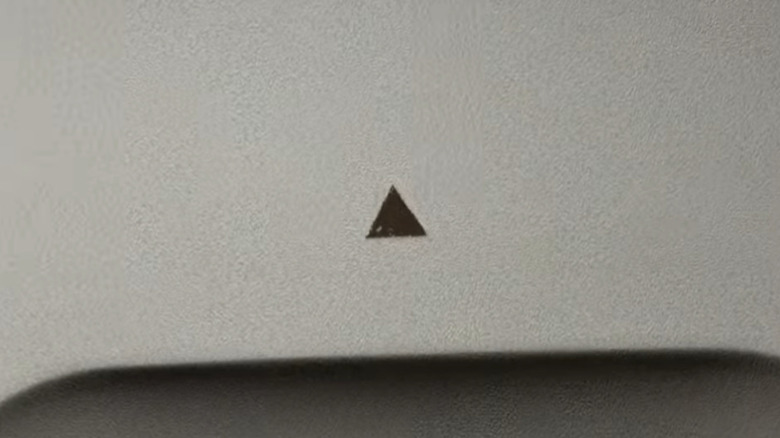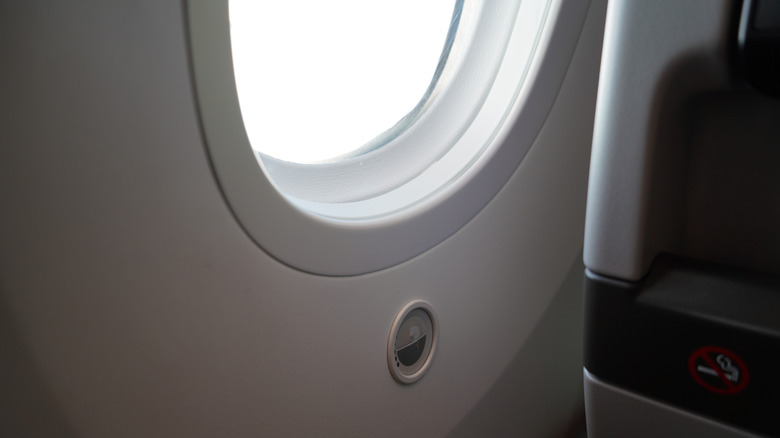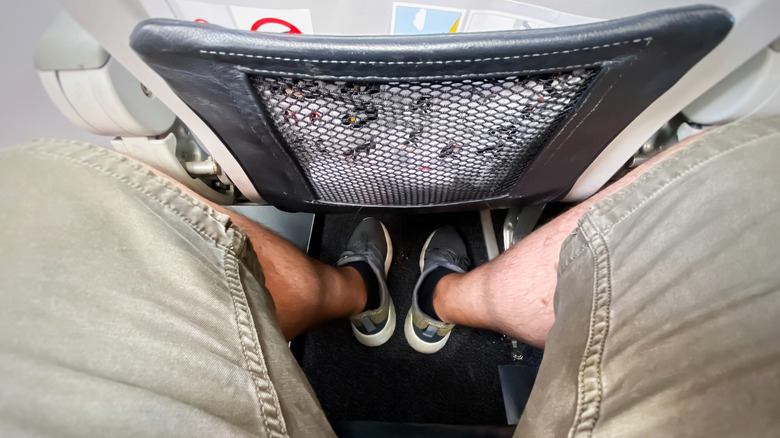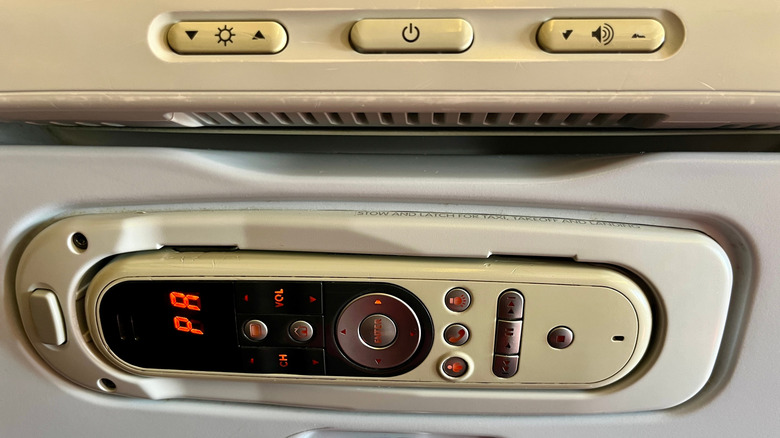Subtle Airplane Cabin Features Only Frequent Flyers Notice
When you fly a lot, you tend to develop a routine for everything. You know exactly how early to get to the airport, what to pack to make the long flight bearable, and what you'll do to keep yourself entertained in the air. Because so much is predictable, you might think that all airplanes are the same, too. However, frequent travelers who have spent the last decade traveling all around the world on all kinds of airplanes, from humongous continent-crossing airbuses to tiny propeller-powered puddle jumpers, know whenever a plane has a unique feature — especially if it's specific to a certain airline or a sign of its age.
With so much time to kill, you may also begin to ask a lot of questions. Like, where do flight attendants sleep on ultra-long haul flights like the 19-hour trip from New York to Singapore? Or why are there ashtrays in airplane bathrooms when smoking has been banned for decades? And what is the point of a window seat without a window? It turns out there really is a reason for everything. Many travelers enjoy collecting these small pieces of trivia and can appreciate when they spot an older feature that connects to the evolution of the flying experience. Noticing these features makes every flight a little bit more interesting, which helps pass the time.
Aisle armrest levers
On first impressions, the aisle seat armrest seems not to budge, unlike the middle seat armrests that can usually be moved. Many people don't know, however, that on most planes, there is a secret lever or button that actually allows you to lift it. You usually have to feel around for it, but it's typically located on the underside towards the back, near the hinge. Most passengers don't even realize this is possible, and I've often spotted other passengers shooting me curious looks whenever I pull off this sneaky trick.
It makes a huge difference to lift the armrest because it gives me a little bit more space to stretch, and it makes getting in and out of the seat easier when your seat neighbors need to pass by. After landing, it's also helpful to lift it as you get up so you can easily rest your belongings on the seat as you wait. If comfort is a priority, check out these genius hacks that make economy more comfortable.
Chargers and outlets
The last thing you want to do is land in your destination with a completely dead phone battery, which is why I always travel with a power bank and check my plane's seat map to see if there will be any power outlets. Websites like SeatGuru allow you to find out whether or not your seat will have an AC outlet, which is useful for charging larger devices like laptops.
However, the seat maps don't always reflect in-flight entertainment systems that might also have a built-in USB or USB-C port, although you don't know which one you might get unless you research the airline beforehand. Travelers who use newer chargers with only USB-C ports may be caught off guard if they board a slightly older plane. For this reason, I like to travel with both kinds of cables in my personal item. New technology trends may also advance the flying experience as well. For example, Lufthansa now offers wireless charging in business class, a feature that may be integrated by more airlines in the future and potentially trickle down to economy class one day.
Adaptive lighting
One of the biggest factors when it comes to making a flight feel more comfortable is one you don't often think about: cabin lighting. Airlines use lights to help passengers adjust to time zone changes with adaptive systems that dim according to an intentional schedule. Airines can also customize these lights and use them to simulate sunrise and sunset. This is intended to help reduce jet lag, which can be particularly bad if you're flying east. On long-haul flights, you may be woken up with bright lights and a breakfast service about an hour before you land. Although flight attendants will let you keep sleeping if you don't wake up.
Some airlines will also customize the lights to their brand colors and find new ways to improve their adaptive lighting systems. Turkish Airlines introduced a specially-designed system that is specifically adapted to the circadian rhythms of the passengers with enhanced colors and synchronicity with the flight schedule.
Overhead cabin design
Everyone knows airplane seats are cramped, but having more space above your head can make you feel like there's a little more room to breathe. Newer planes like the Airbus A350 have high ceilings that are designed so passengers feel less confined on long-haul flights, reaching up to 8 feet high. In the center aisle, there is even more room because the overhead bins are fully recessed into the ceiling. The extra space also improves lighting and airflow.
Modern airplanes are also introducing larger overhead bins called "L Bins" that are designed so that carry-on luggage can be stored on their side, which leaves more room for everyone's bags. On older models, narrow bins require bags to lie flat, which leaves a lot of extra space that also tends to get filled up with jackets and smaller bags that people throw on top of their bags. If you do get lucky enough to fly on one of the newer planes, make sure to appreciate all the freed-up overhead space.
Bluetooth entertainment systems
Wireless headphones and earbuds are so commonplace these days that many new phones no longer come with headphone jacks. This is great for almost every other daily scenario, but when you finally get settled in your seat and start browsing through movies, you suddenly realize you have no way to plug into the console. Airlines will usually hand out complimentary, wired earbuds so you can still watch a movie, but the sound quality is often not ideal. I also recommend finding hybrid wireless headphones (which come with a removeable wire for backup).
Occasionally, you may be able to access Bluetooth on your flight's entertainment system, but only if the airline has taken the trouble to make the expensive upgrade, as United did in 2023 when they retrofitted over 100 planes with Bluetooth-enabled seatback screens. The only challenge you might face will happen when first pairing your device to your seat. Because there will be many other people in a confined area trying to do the same, it might take a minute to find your device, so make sure it has a unique name that will be easy to recognize.
Window bleed holes
Next time you get a window seat, take a closer look at the glass itself and find the small hole towards the bottom of the window frame. This isn't a crack or flaw, but actually an intentional part of the airplane design known as a "bleed hole." To begin to understand their purpose, you should know a little bit about how airplane cabin pressure works. When an airplane is soaring thousands of feet in the air, there is a big difference between the pressure outside and inside the cabin. This is done purposefully to keep the cabin comfortable for passengers and simulate the pressure we're used to on the ground. If not for this technology, we would have a much harder time breathing while flying at altitude.
With such a huge difference in pressure inside and outside the cabin, the three-paned windows have to be strong enough to withstand the stress. The bleed hole in the center pane maintains the pressure in between, particularly when there are sudden changes. It's an essential feature to prevent the windows from failing.
Crew rest compartments
It's not only the first-class passengers who enjoy the luxury of lying down. On long-haul flights, the crew gets a chance to rest, too — but these secret compartments are hidden away from passengers' eyes. Crew rest compartments vary by plane, but they can be located above the main cabin, in the cargo hold, or — specifically for pilots — above the cockpit. The bunks give the crew sufficient space to lie down, although they can be quite cramped without much space overhead. The idea is to give all the employees a chance to rest, so they will be alert and ready to respond to any safety issues throughout the shift.
You can try looking for the secret entrances of these cabins, but they are usually very well hidden, typically disguised as a closet or an unmarked door that resembles a bathroom. Even if you do figure it out, the only way to get inside is to join the crew.
Headrest wings
Every airplane seat is equipped with a headrest, which can not only be adjusted for height, but also has bendable wings that might help you get in a more comfortable position. While they're nowhere near as comfortable as a neck pillow for sleeping, manipulating them in a certain way can help you keep your travel pillow in place. Although, for some, they might be placed too high to be useful, especially if they're unadjustable.
As one Reddit user wrote, "I'd remove the headrest if I could. For shorter people, it's painful because it pushes our neck/head forward, so we're uncomfortably hunched over the whole time. It doesn't align with our neck and shoulders as it does for taller people. And most of them aren't adjustable to move them down." Generally, airlines don't give much thought to the design of their headrests, but if they did, it might make a big difference in improving passenger comfort, especially on long flights where everyone is looking to get a little shut-eye.
Ashtrays in the bathroom
Smoking on airplanes is a practice that seems so archaic, we only really associate it with old movies. However, there are still many remnants of how common it used to be. Before smoking was completely banned on flights to, from, and within the U.S. in 2000, some airlines still allowed smoking as they did during the golden days of travel — when cigarettes were even offered amenity as part of the airline service. Now, you'd have to be living under a rock to not know that smoking is strictly forbidden on planes. So why are there still ashtrays in the bathroom?
According to the Federal Aviation Administration (FAA) regulations, ashtrays are required in cabin bathrooms to prevent any rule-breaking smoker from disposing of their cigarette into the garbage. Basically, the FAA knows eventually someone is bound to break the rules, usually by hiding in the bathroom where they can smoke out of sight of the flight attendants. When they do, there needs to be a safe place for them to put out their cigarette. Otherwise, they might try to throw the cigarette butt in the same place people throw away their paper towels. Adding to the irony, these ashtrays are usually emblazoned with another "no smoking" symbol.
Temperature zones
If you're looking at the flight map to pass the time, take a note of the outside air temperature during the middle of your flight. When you're flying above 30,000 feet, it can be anywhere between -30 to -40 degrees Fahrenheit, but that hardly affects you as a passenger because, like air pressure, the temperature in the plane is strictly controlled. However, if you decide to stretch your legs and walk down the aisle through the different cabins, you might notice some temperature changes.
Each section of the airplane, typically divided by curtains or galleys, features an independent temperature control system. These sections include the flight attendant workstation and the bathrooms. Airlines try to keep the temperature between 71 and 75 degrees Fahrenheit, but there are always rows that are colder or warmer than others, depending on how the air is distributed. This means that you could be freezing, while someone a few rows back is totally comfortable. There's really no way to know what kind of seat you'll get, so always bring extra layers when you fly in case it's a chilly one.
Windowless seats
The only thing worse than a middle seat is a window seat without a window. Not only do you have to disturb two people to get and use the bathroom, but also, instead of a view of the clouds, you get nothing but a boring, plastic wall. These seats are pretty rare on planes, which means the odds of you getting this unlucky are pretty low — but someone has to get it in the end. That's why it's always a good idea to cross-reference your aircraft with the maps on SeatGuru if you're thinking about paying extra for a window seat.
These seats exist because that part of the wall has a key piece of airplane technology behind it, or it could be a place where parts of the plane are fused. It could also be explained by the way the airline chose to retrofit its fleet to allow more seats — often sacrificing legroom or to incorporate special seating. Of course, these might not align properly with the aircraft's original design. This is also why you sometimes get that strange window that seems to be between two rows.
Black triangles
You don't find them on every plane, but occasionally these black triangles have prompted travelers to wonder about their purpose. You can usually find them located above the window, specifically in rows that look out over the wing of the plane. The black triangles make it easy for flight attendants to identify which row to go to, in case they need to check on the wings for any reason. Although you may not be able to tell immediately if you will be in a black triangle seat when you book your ticket, consider it a lucky sign if you get one. The window seat is ideal for taking those aesthetic photos from high up in the sky.
Whether or not the little black triangles will be there really comes down to the airline and the luck of the draw. While this is interesting trivia, it doesn't affect your trip much, especially since you will be able to tell which row is next to the wing when you reserve your seat at check-in.
Self-dimming windows
The typical airplane window has a physical shade that lets the passenger control how much light is let in by pulling it up and down. These are essential for travelers who are flying across time zones and may want to get some rest without being woken up by the sunlight. However, it's becoming more and more common on newer plane models that windows are being installed with self-dimming technology. The beauty of windows that dim electronically is that you can still achieve the same light-blocking effect without totally losing the view, although it will be a bit harder to see.
These windows work by running an electrical current through a layer of gel on the window, which causes a chemical reaction that darkens the gel. The windows can be turned on and off with the touch of a button, and even set to varying degrees of darkness. The windows are also connected to the same network, which means you won't hear the flight attendants going around anymore to ask people to open and close their windows. Instead, they have a button that automatically darkens and brightens all the windows, so they can prepare the plane for takeoff and landing.
Footrests
This amenity is usually reserved for passengers in Premium Economy and above, but once you fly with a footrest, you'll never want to go back. Of course, for passengers who are a bit on the shorter side, the lack of legroom may not be a problem. Still, many may be more comfortable when they have something to press their feet against — and preferably not to be their personal item that may have their expensive laptop inside it.
Airplanes that offer footrests make them retractable, so they won't get in the way if you have longer legs and are short on space. Most of the time, you won't find them in economy seats or on planes that primarily run short-haul flights. However, you can buy your own and pack it with you. Some models even improve on what the plane hardware can offer with hammock-style footrests that use memory foam for extra comfort. Inflatable footrests are also useful if you're traveling with children, because they can transform the seat into a makeshift bed, on which they can lie flat. Basically, with the right accessories, you can make your own first class.
Armrest remote
I'd confidently wager that the oldest plane I've ever flown on was the one that had personal ashtrays in every seat. However, any plane with a physical remote nestled into the armrest has to be a close second. Now that we're all used to touchscreen interfaces on just about every piece of technology we come into contact with, these remotes feel extra archaic, especially if you need to use them to control the entertainment system in front of you.
When you do board a plane that has them, it's about as fun as running to an old high school teacher. Some travelers even find them to get in the way with their arms constantly pressing up against the buttons. However, there are some advantages to the analog remote over the touchscreen. For one, you can stay reclined as you swipe through different movies, and they may even have special button setups that make it easier to play games. It's true, I can only play so much solitaire in a hunched forward position before I give up and look for some other distraction.
